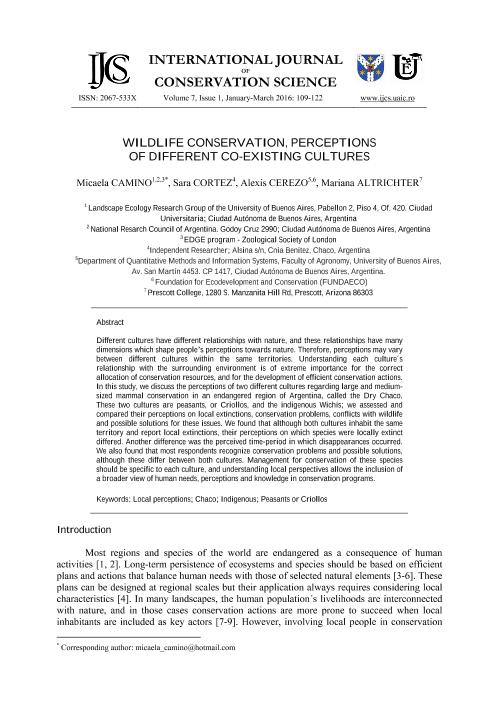Mostrar el registro sencillo del ítem
dc.contributor.author
Camino, Micaela

dc.contributor.author
Cortez, Sara
dc.contributor.author
Cerezo, Alexis
dc.contributor.author
Altrichter Mariana
dc.date.available
2019-11-22T14:08:34Z
dc.date.issued
2016-03
dc.identifier.citation
Camino, Micaela; Cortez, Sara; Cerezo, Alexis; Altrichter Mariana; Wildlife Conservation, perceptions of different co-existing cultures; Alexandru Ioan Cuza University; International Journal of Conservation Science; 7; 1; 3-2016; 109-122
dc.identifier.issn
2067-533X
dc.identifier.uri
http://hdl.handle.net/11336/89529
dc.description.abstract
Different cultures have different relationships with nature, and these relationships have many dimensions which shape people’s perceptions towards nature. Therefore, perceptions may vary between different cultures within the same territories. Understanding each culture´s relationship with the surrounding environment is of extreme importance for the correct allocation of conservation resources, and for the development of efficient conservation actions. In this study, we discuss the perceptions of two different cultures regarding large and mediumsized mammal conservation in an endangered region of Argentina, called the Dry Chaco. These two cultures are peasants, or Criollos, and the indigenous Wichís; we assessed and compared their perceptions on local extinctions, conservation problems, conflicts with wildlife and possible solutions for these issues. We found that although both cultures inhabit the same territory and report local extinctions, their perceptions on which species were locally extinct differed. Another difference was the perceived time-period in which disappearances occurred. We also found that most respondents recognize conservation problems and possible solutions, although these differ between both cultures. Management for conservation of these species should be specific to each culture, and understanding local perspectives allows the inclusion of a broader view of human needs, perceptions and knowledge in conservation programs.
dc.format
application/pdf
dc.language.iso
eng
dc.publisher
Alexandru Ioan Cuza University
dc.rights
info:eu-repo/semantics/openAccess
dc.rights.uri
https://creativecommons.org/licenses/by-nc-sa/2.5/ar/
dc.subject
Local perceptions
dc.subject
Chaco
dc.subject
Indigenous
dc.subject
Peasants or Criollos
dc.subject.classification
Conservación de la Biodiversidad

dc.subject.classification
Ciencias Biológicas

dc.subject.classification
CIENCIAS NATURALES Y EXACTAS

dc.title
Wildlife Conservation, perceptions of different co-existing cultures
dc.type
info:eu-repo/semantics/article
dc.type
info:ar-repo/semantics/artículo
dc.type
info:eu-repo/semantics/publishedVersion
dc.date.updated
2019-10-04T18:38:32Z
dc.journal.volume
7
dc.journal.number
1
dc.journal.pagination
109-122
dc.journal.pais
Azerbaiyán

dc.description.fil
Fil: Camino, Micaela. Consejo Nacional de Investigaciones Científicas y Técnicas. Centro Científico Tecnológico Conicet - Nordeste. Centro de Ecología Aplicada del Litoral. Universidad Nacional del Nordeste. Centro de Ecología Aplicada del Litoral; Argentina. Universidad de Buenos Aires. Facultad de Arquitectura y Urbanismo. Grupo de Ecología del Paisaje y Medio Ambiente; Argentina
dc.description.fil
Fil: Cortez, Sara. No especifica;
dc.description.fil
Fil: Cerezo, Alexis. Universidad de Buenos Aires. Facultad de Agronomía. Departamento de Métodos Cuantitativos y Sistemas de Información; Argentina
dc.description.fil
Fil: Altrichter Mariana. Prescott University; Estados Unidos
dc.journal.title
International Journal of Conservation Science
dc.relation.alternativeid
info:eu-repo/semantics/altIdentifier/url/http://www.ijcs.uaic.ro/public/IJCS-16-10_Camino.pdf
Archivos asociados
